初中英语语法专题
- 格式:docx
- 大小:30.44 KB
- 文档页数:6
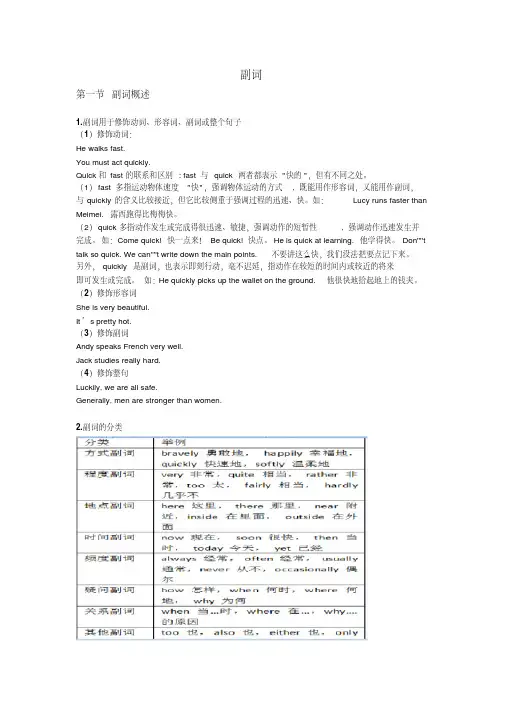
副词第一节副词概述1.副词用于修饰动词、形容词、副词或整个句子(1)修饰动词:He walks fast.You must act quickly.Quick和fast的联系和区别: fast 与quick 两者都表示"快的",但有不同之处。
(1)fast多指运动物体速度"快",强调物体运动的方式, 既能用作形容词,又能用作副词,与quickly的含义比较接近,但它比较侧重于强调过程的迅速、快。
如:Lucy runs faster than Meimei. 露西跑得比梅梅快。
(2)quick多指动作发生或完成得很迅速、敏捷,强调动作的短暂性, 强调动作迅速发生并完成。
如:Come quick! 快一点来!Be quick! 快点。
He is quick at learning. 他学得快。
Don''''t talk so quick. We can''''t write down the main points. 不要讲这么快,我们没法把要点记下来。
另外,quickly是副词,也表示即刻行动,毫不迟延,指动作在较短的时间内或较近的将来即可发生或完成。
如:He quickly picks up the wallet on the ground. 他很快地拾起地上的钱夹。
(2)修饰形容词She is very beautiful.It’s pretty hot.(3)修饰副词Andy speaks French very well.Jack studies really hard.(4)修饰整句Luckily, we are all safe.Generally, men are stronger than women.2.副词的分类第二节副词的构成和比较等级1.形容词构成副词的一般规则有些形容词和副词同形,如:back adj. 后面的back adv. 向后地2.副词的比较等级(1)单音节词,加-er和-est(2)双音节词及多音节词,加more 和most但是early 的比较级和最高级则分别为:earlier earliest (3)不规则变化的词farther/ farthest, further /furthest的用法farther/ farthest和further /furthest都可用于表示距离和时间上的远We can go farther/further.We can look back farther/further into the past to find the truth.further /furthest 还可表示程度上的“深远”“进一步”The police will research further into this matter.3.原级比较常用句型,,as+副词原级+as,.该句型表示:,.和,..一样He speaks as loudly as you do.,.not as (so)+副词原级+as...该句型表示:,..不如,..I can’t walk as/so fast as you.他没有你反应的快。
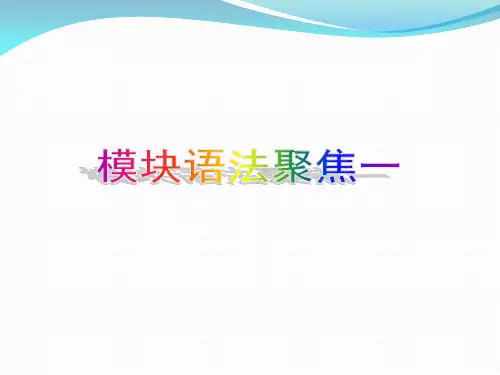
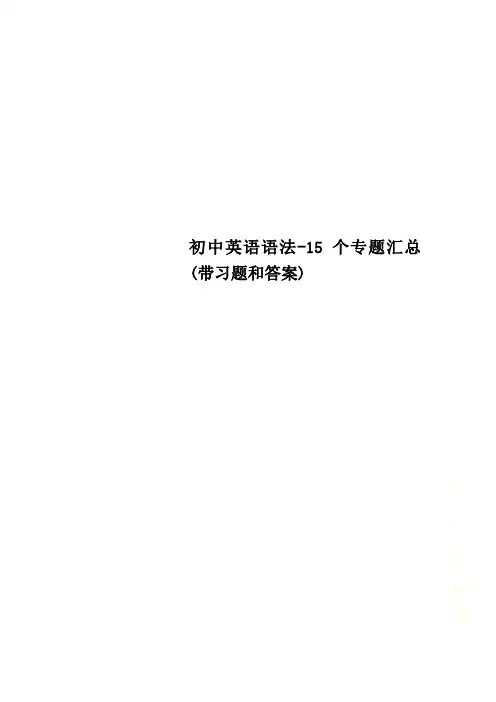
初中英语语法-15个专题汇总(带习题和答案)目录专题一名词 (2)专题二数词、冠词 (9)专题三介词、连词 (15)专题四代词 (22)专题五形容词、副词 (31)专题六动词的分类 (39)专题七情态动词、系动词 (46)专题八动词时态 (53)专题九被动语态 (60)专题十非谓语动词 (66)专题十一简单句、并列句 (76)专题十二祈使句、感叹句 (84)专题一三宾语从句 (91)专题一四定语从句 (99)专题一五状语从句 (106)专题一名词1.名词的数1.概述: 名词按其表示的事物的性质分为可数名词和不可数名词。
2.可数名词及其单复数:可数名词有单复数变化,其前通常用不定冠词和数词来修饰,还可用many, few, a few, some, any, plenty of, lots of, a number of 等修饰。
构成名词复数形式的方法分为规则法和不规则法两种。
1)复数的规则构成法:绝大多数英语中的名词复数都是在单数名词后加上词尾-s或-es构成的。
具体规则如下图:a.单复同形的:Chinese-Chinese, Japanese-Japanese, deer-deer, sheep-sheep,fish-fish(表示鱼的数量)b. 熟记下列词的复数变化:man-men, woman-women, policeman-policemen, foot-feet, tooth-teeth, mouse-mice, child-childrenc. 以man, woman做定语构成的复合名词,变复数时要全变:a man teacher-two men teachers; 其他情况一般只变主体名词而作定语的名词不变:a girl student-two girl students3. 不可数名词:不可数名词没有单复数。
如:water, meat, air等。
在表示数量时,通常用以下方法。

初中英语语法专题--副词一、副词定义:1.用来说明事情或动作发生的时间、地点、原因、方式等含义的词2.用来说明其它形容词或副词程度的词二、副词的分类副词按词汇意义和句法功能可分为时间副词、地点副词、频度副词、程度副词、方式副词、疑问副词、连接副词、关系副词等。
初中主要学习和掌握频度副词、方式副词、时间副词、地点副词即可。
考点一副词的分类与位置1、表频率的副词常见的频率副词有:always,often,usually,sometimes,never,ever,hardly,seldom.它们一般在行为动词之前,系动词、情态动词和助动词之后,.①He always goes t o school on foot.②She has never been to Beijing.③She is often late for work.2、表示方式的副词与方式相关的副词,如safely,quietly,quickly,politely loudly,luckily ,happily ,easily ,carefully ,slowly ,suddenly以及fast,late,hard,early等。
此类副词位于动词之后,如果是及物动词一般位于宾语之后。
①The children are dancing happily.②They work hard.③The students did their homework carefully.3.程度副词与程度相关的副词有:very , much , only, quite , as, too, too…for,too…to do, well, almost, even, a little , enough , rather, a lot , so,such , badly, nearly , further , really , widely , hardly , a bit等。


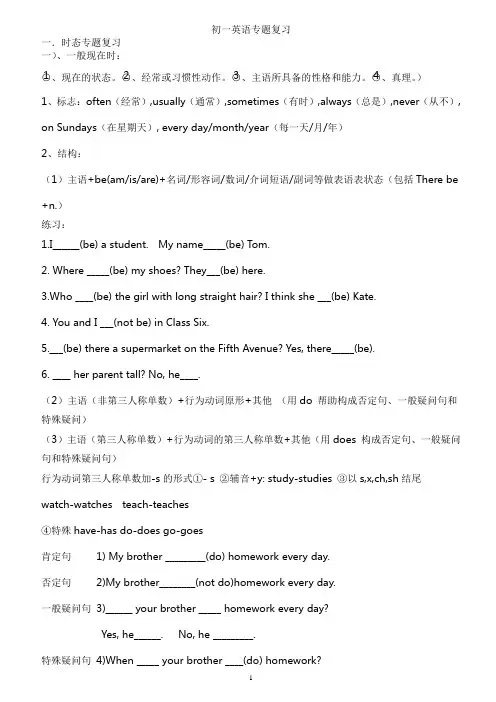
初一英语专题复习一.时态专题复习一)、一般现在时:○1、现在的状态。
○2、经常或习惯性动作。
○3、主语所具备的性格和能力。
○4、真理。
)1、标志:often(经常),usually(通常),sometimes(有时),always(总是),never(从不), on Sundays(在星期天), every day/month/year(每一天/月/年)2、结构:(1)主语+be(am/is/are)+名词/形容词/数词/介词短语/副词等做表语表状态(包括There be +n.)练习:1.I______(be) a student. My name_____(be) Tom.2. Where _____(be) my shoes? They___(be) here.3.Who ____(be) the girl with long straight hair? I think she ___(be) Kate.4. You and I ___(not be) in Class Six.5.___(be) there a supermarket on the Fifth Avenue? Yes, there_____(be).6. ____ her parent tall? No, he____.(2)主语(非第三人称单数)+行为动词原形+其他(用do 帮助构成否定句、一般疑问句和特殊疑问)(3)主语(第三人称单数)+行为动词的第三人称单数+其他(用does 构成否定句、一般疑问句和特殊疑问句)行为动词第三人称单数加-s的形式①- s ②辅音+y: study-studies ③以s,x,ch,sh结尾watch-watches teach-teaches④特殊have-has do-does go-goes肯定句 1) My brother _________(do) homework every day.否定句 2)My brother________(not do)homework every day.一般疑问句 3)______ your brother _____ homework every day?Yes, he______. No, he _________.特殊疑问句 4)When _____ your brother ____(do) homework?巩固1.写出下列单词的第三人称单数形式。
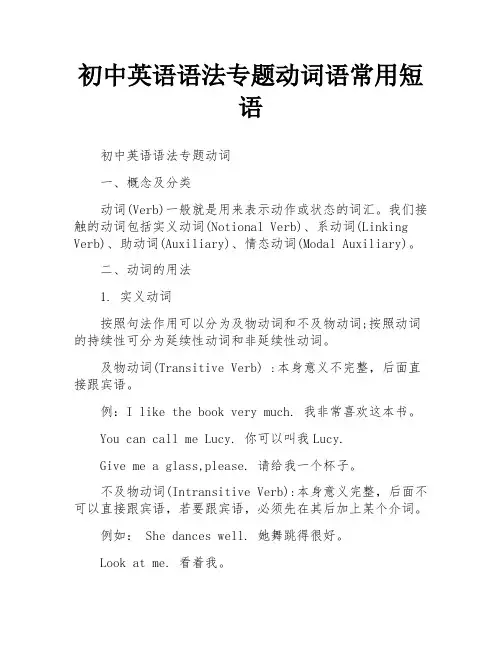
初中英语语法专题动词语常用短语初中英语语法专题动词一、概念及分类动词(Verb)一般就是用来表示动作或状态的词汇。
我们接触的动词包括实义动词(Notional Verb)、系动词(Linking Verb)、助动词(Auxiliary)、情态动词(Modal Auxiliary)。
二、动词的用法1. 实义动词按照句法作用可以分为及物动词和不及物动词;按照动词的持续性可分为延续性动词和非延续性动词。
及物动词(Transitive Verb) :本身意义不完整,后面直接跟宾语。
例:I like the book very much. 我非常喜欢这本书。
You can call me Lucy. 你可以叫我Lucy.Give me a glass,please. 请给我一个杯子。
不及物动词(Intransitive Verb):本身意义完整,后面不可以直接跟宾语,若要跟宾语,必须先在其后加上某个介词。
例如: She dances well. 她舞跳得很好。
Look at me. 看着我。
延续性动词(Durative Verb):表示动作是可以持续的,可以和表示时间的状语连用。
例如:We have lived here for 20 years. 我们已经在这里住了20年了。
非延续性动词(Non-durative Verb):表示瞬间动作,动作一旦发生立即结束,不能和表示一段时间的状语连用。
如果和表示一段时间的状语连用,要用其它的词代词。
例如: She has kept the book for 2 months. 她借这本书已经2个月了。
(这里不能用has borrowed)2. 系动词系动词本身有词义,但不能单独使用,和表语在一起组成主系表结构,说明主语的状态、性质、特征和身份。
常见的系动词如下:be 动词am/is/are/was/wereget/turn/e/go/bee/grow变化系动词feel/sound/look/smell/taste后面必须加形容词感官系动词keep/remain/stay保持系动词似乎系seem动词例如: I am a student. 我是一个学生。

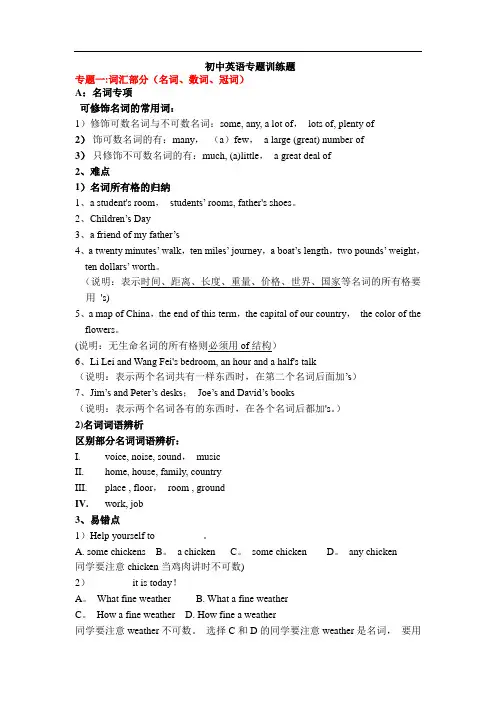
初中英语专题训练题专题一:词汇部分(名词、数词、冠词)A:名词专项可修饰名词的常用词:1)修饰可数名词与不可数名词:some, any, a lot of,lots of, plenty of2)饰可数名词的有:many,(a)few,a large (great) number of3)只修饰不可数名词的有:much, (a)little,a great deal of2、难点1)名词所有格的归纳1、a student's room,students’ rooms, father's shoes。
2、Children’s Day3、a friend of my father’s4、a twenty minutes’ walk,ten miles’ journey,a boat’s length,two pounds’ weight,ten dollars’ worth。
(说明:表示时间、距离、长度、重量、价格、世界、国家等名词的所有格要用's)5、a map of China,the end of this term,the capital of our country,the color of the flowers。
(说明:无生命名词的所有格则必须用of结构)6、Li Lei and Wang Fei's bedroom, an hour and a half's talk(说明:表示两个名词共有一样东西时,在第二个名词后面加’s)7、Jim’s and Peter’s desks;Joe’s and David’s books(说明:表示两个名词各有的东西时,在各个名词后都加's。
)2)名词词语辨析区别部分名词词语辨析:I.voice, noise, sound,musicII.home, house, family, countryIII.place , floor,room , groundIV.work, job3、易错点1)Help yourself to _________。
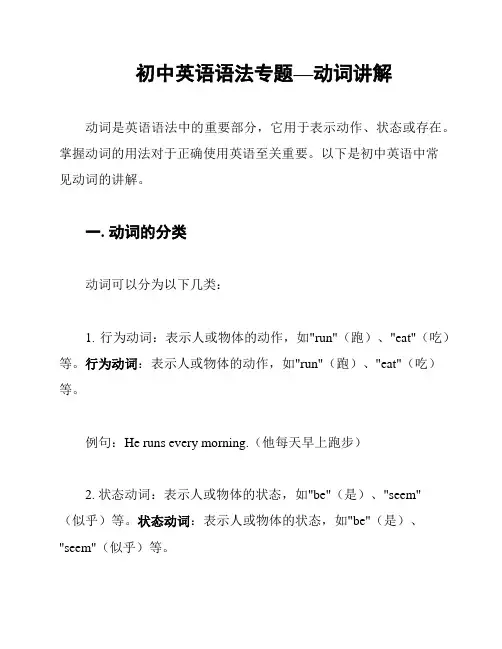
初中英语语法专题—动词讲解动词是英语语法中的重要部分,它用于表示动作、状态或存在。
掌握动词的用法对于正确使用英语至关重要。
以下是初中英语中常见动词的讲解。
一. 动词的分类动词可以分为以下几类:1. 行为动词:表示人或物体的动作,如"run"(跑)、"eat"(吃)等。
行为动词:表示人或物体的动作,如"run"(跑)、"eat"(吃)等。
例句:He runs every morning.(他每天早上跑步)2. 状态动词:表示人或物体的状态,如"be"(是)、"seem"(似乎)等。
状态动词:表示人或物体的状态,如"be"(是)、"seem"(似乎)等。
例句:She is happy today.(她今天很开心)3. 助动词:用于构成各种时态、语态和情态动词,如"be"、"do"、"have"等。
助动词:用于构成各种时态、语态和情态动词,如"be"、"do"、"have"等。
例句:I have been to London.(我去过伦敦)4. 情态动词:用于表示说话者的意图、愿望、能力、许可等,如"can"(能)、"may"(可能)等。
情态动词:用于表示说话者的意图、愿望、能力、许可等,如"can"(能)、"may"(可能)等。
例句:You can go home now.(你现在可以回家了)二. 动词的时态动词的时态用于表示动作或状态发生的时间。
常见的时态有以下几种:1. 一般现在时:表示经常性或惯性的动作或状态。
一般现在时:表示经常性或习惯性的动作或状态。
初中英语语法大全(精华版)一、动词时态1. 一般现在时:表示经常性、习惯性的动作或状态。
例如:He goes to school bike every day.(他每天骑自行车上学。
)2. 一般过去时:表示过去某个时间里发生的动作或存在的状态。
例如:She visited her grandparents last weekend.(她上周末去看望了她的祖父母。
)3. 一般将来时:表示将来要发生的动作或状态。
例如:We will have a sports meeting next month.(下个月我们将举行一场运动会。
)4. 现在进行时:表示正在进行的动作或状态。
例如:The boy is reading a book in the library.(这个男孩正在图书馆看书。
)5. 过去进行时:表示过去某个时刻正在进行的动作或状态。
例如:They were watching TV when I called them last night.(昨晚我给他们打电话时,他们正在看电视。
)6. 现在完成时:表示过去发生的动作对现在造成的影响或结果。
例如:I have finished my homework.(我已经完成了我的家庭作业。
)二、名词1. 名词的分类:名词分为可数名词和不可数名词。
可数名词有单数和复数形式,不可数名词没有复数形式。
2. 名词的数:可数名词的复数形式通常在词尾加s或es。
例如:books(书),pencils(铅笔)。
3. 名词的所有格:表示某物属于某人或某事物的关系。
例如:Tom's book(汤姆的书),the teacher's desk(老师的桌子)。
三、冠词1. 不定冠词:a和an。
a用于辅音音素开头的单词前,an用于元音音素开头的单词前。
例如:a dog(一条狗),an apple(一个苹果)。
2. 定冠词:the。
表示特指,指某个特定的人或事物。
初中英语语法专题(合集12篇)初中英语语法专题第1篇feel do 感觉某人做了某事have do 使某人做某事hear do 听见某人做某事let do 让某人做某事listen to do 听着某人做某事look at do 看着某人做了某事make do 使某人做某事notice do 注意某人做了某事observe do 观察某人做了某事see do 看见某人做了某事watch do 观察某人做了某事初中英语语法专题第2篇(1) remember to do 记住要做某事remember doing 记住曾做过某事(2) forget to do 忘记要做某事forget doing 忘记曾做过某事(3) regret to do 后悔(遗憾)要做某事regret doing 后悔(遗憾)曾做过某事(4) try to do 努力去做某事try doing 尝试做某事(5) mean to do 打算做某事mean doing 意味着做某事(6) can’t help to do 不能帮助做某事can’t help doing 禁不住做某事(7) go on to do 做完某事后接着做另一事go on doing 继续做一直在做的事初中英语语法专题第3篇like to do sth / like doing 喜欢做某事love to do sth / love doing 喜欢做某事hate to do sth / hate doing 憎恨做某事prefer to do sth / prefer doing 宁可做某事begin to do sth / begin doing 开始做某事continue to do sth / continue doing 继续做某事can’t bear to do sth / can’t bear doing 不能忍受做某事 bother to do sth / bother doing 麻烦做某事intend to do sth / intend doing 打算做某事attempt to do sth / attempt doing 试图做某事cease to do sth / cease doing 停止做某事初中英语语法专题第4篇名词一、英语名词可分专有名词和普通名词两大类:1、专有名词是个别的人、地、物、团体、机构等的专用名称。
初中英语语法专题介词与常见短语介词(preposition 简写prep.),又称作前置词,表示名词、代词等与句中其它词的关系,在句中不能单独作句子成分。
我在这里整理了相关资料,快来学习学习吧!初中英语语法专题介词一、概念介词(preposition)表示与名词、代词等其它词的关系,不能单独做句子成分,介词后面的成分称为宾语。
二、分类介词可以用来表示时间、地点、方位、方式、手段等。
①重点词整理解析(at\in\on\by\before\after\until\for\since)at1. at+点钟at one oclock 在七点钟2. at+the+n s (shop) at the bakers (shop) 在面包店at the hairdressers (shop)在理发店3. at noon/night/midnight 在正午/夜晚/午夜4. at home/work/school/church 在家/上班/上学/做礼拜5. at breakfast/lunch/dinner 在吃早/午/晚饭6. arrive at+小地点arrive at the airport 到机场7. at+节日at Spring Festival 在春节期间8. call sb at+号码打...号码找某人9. email sb at+邮件地址发...电子邮件给某人10. call at +地点探望某个地方11. 其它固定搭配at the price/speed...of 以...的价格、速度in1. in+年、月in 20xx/May 在20xx年五月2. in+季节in Summer 在夏天3. in the morning/afternoon/evening 在早上/下午/晚上4. in+世纪in the twenty-first century 在21世纪5. in+颜色表示穿着the girl in red 穿红色衣服的女孩6. in+语言in English/Chinese 用英语/汉语7. in+声音in a weak voice 用微弱的声音8. in+时间段表示将来in five minutes 五分钟以后(划线提问用how soon)9. in+地点(大地点) in Qingdao 在青岛10. in+物体在...里面in the glass 在杯子里11. in+方向in the west 在西边12. 其它in front of 在...前面in the end 最终in the past few years 在过去的几年里on1. on+详细日期/礼拜on May 8th 在五月八日on Wednesday 在周三2. on+ 节日(带Day 的节日) on Mothers Day 母亲节3. on+地点on the table(在桌子上) on the train(在火车上)4. call on+sb call on your friend 探望你的挚友5. 表示方位(毗邻、接壤) Russia is on the north of China. 俄罗斯与中国北部相连。
语法专题第一部分词法专题I 名词、冠词一、名词的分类(一)可数名词:单数和_____数。
A、可数名词单数变复数:将下列名词变成复数形式,并总结一下可数名词单数变复数的规律。
1.glass/box/watch/wish___2.(1) radio/zoo/kilo/photo/piano_____ (2) Negro(黑人)/hero/tomato/potato______3.country/city/dictionary/strawberry______4.key/boy/holiday_____5.leaf/half/-self/knife_____B、记住:少数名词的复数形式比较特殊:1.man---______woman---_________policeman---____________German---_______2.child---_______3.foot---________ tooth---_________ mouse----_________4.Chinese---_________Japanese---__________people---_________sheep---_______ fish(指鱼的条数)---________ deer---________(二)不可数名词:是指不能以数目来计算,不可分成个体的概念、状态、品质、感情或物质材料的东西。
如:friendship, love, milk, tea, fun等,它一般没有复数形式,只有单数形式,但它的前面不能用a/an。
如果要表示它的个体意义时,其表示法:“数词+ 单位(s/es)+of+不可数名词”二、名词所有格(...的...)1.有生命的名词(人):---’s(单数), ---s’(复数), 如:玛丽的书:______________; 儿童节:____________________;母亲节:________________; 教师节:____________________2.无生命的名词(物):--of---, --- to---,如:一张中国地图:___________________ 一张全家福:_____________________这个问题的答案:_________________ ....的秘诀:________________________三、冠词:1. 分类:不定冠词(___/___)和定冠词(____)2.用法:放在名词前修饰或限定名词。
Exx:(1) ____UFO ____useful book_____university_____European country(2)____eight-year-old girl ____unusual day ____hour ____honest boy(3)____Great Wall ____second language ____longest river _____rich/poorI received a gift on New Year’s Day. ____ gift is very beautiful.专题II 代词teach oneself___________ help oneself to +食物__________二、不定代词3.一些:(1)some/any+ _____/_____ (2)several+______数4.a few +____数,译为______; few + _____数,译为_______a little + _____数名词,译为______; little + ______数名词,译为________.5.both _______,neither_________, either_______.A. Both you and I _______(be) students.B. Neither you nor I ________(be) students.C. Neither of my parents ________(be) Japanese.D. Either of the answer ______(be) right.6.all________, none_________, any_________.7.区别other, others, the other, the others, another.8.区别each 和every: (1) each/every +____词_____数(2) each of + 代词9.指示代词单复数:this/______; that/_________.10.疑问代词:what______; who/whom_______; whose________; which_________【提升练习】()1.These books are not _____, but_______.A.our; yoursB. yours; theirsC.him; mine()2.—Is this picture______? —No, it’s not______.A.your; mineB.yours; myC.yours; mine()3.Tom did all the work by_______. A. him B. himself C.he()4.Your teacher must be in the office. I_____saw her a minute ago.A.meB. myC. myself()5._____was colder yesterday than today. A. It B. That C.This ()6.There is _____milk at home. Let’s go to buy some.A.littleB. a littleC. a fewD. few()7._____are in the same school.A.You, he and IB. You, I and heC. I, you and he()8.My parents are ________interested in Jazz. A. all B. both C.each ()9. I am new here. So I have ____friends. A. a few B. few C. little ()10.There is only ______ water in the bowl. A. a little B. a few D. little专题III 形容词、副词一、形容词、副词的用法:1.the+adj.表示一类人或物复数。
E.g: 穷人很可怜。
_____ poor _____ poor.2.形容词+ly→副词。
注意:friendly, lovely, lively, lonely等都是形容词。
【练习】(1)Sports stars are healthy because they usually eat _____(good/well).(2)_______, I was alive after a big earthquake. (luck/lucky/luckily)(3)The food in the restaurant tastes ________(good/ well)二、形容词、副词的比较级:分为_____级、_____级和______级。
1.+er/est2.more/less+多音节词;the most/least +多音节词3.记住以下不规则变化:good/well -______-_______ bad/badly/ill -______-____ many/much -______-________ little -_______-_______ far -________-_________ old -_______-________4.句型:(1)越...越......:The+比较级+(陈述句一),the +比较级+(陈述句二)。
The+more...., the more .....(2)越来越....:比较级and比较级;more and more+原形(3)和...一样:as+原级+as... ;(4)和...不一样:not as/so....as...【练习】1.Which is ______, the sun or the moon? A.big B. bigger C.biggest3.Whose handwriting is_____, Lin Tao, Jim or Tom? A.good B.better C.best4.He is one of_____teachers in our school.A.popularB. more popularC. the most popular5.I’ll work _____I can. A. as hard as B. as hardly as C. so hard as专题IV 数词、介词、连词一、数词数词分为基数词和序数词。
用于表示事物数目的词称为基数词,表示事物顺序的词称为序数词。
1.基数词(hundred, thousand, million, trillion)100—one hundred 200—two hundred 250—two hundred and fifty365—three hundred and sixty-five 3000—three thousand30,000—thirty thousand 5000,000—five million1,000,000,000—one trillion2.基数词变序数词的方法:一二三,特殊记,th从四上起,八加h, 九减e, f要把ve替。
One—______ two—_______three—________ four—________five—________ eight—________ nine—________twenty—________twelve—_________ twenty-one—___________3.数词的应用:A.时刻表达法:a.整点:基数词+ o’clock eg: It’s eight o’clock.b.几点几分:1.直接表达法:先小时后分eg: 3:25 three twenty-five2.间接表达法:先分后小时1)(<30分钟)用past:分钟+past+小时eg: 3:25 twenty-five past three2)(>30分钟)用to: (60-分钟)+to+(小时数+1)3)30分钟=_______; 15分钟= a _________B.序数词与不定冠词a/an连用表“又一,再一”Eg: You’ve done it three times. Why don’t you try a fourth time?C.分数的表达:分子(基数)/ 分母(序数)Eg: one third (三分之一) two thirds(三分之二)注意:1.分子超过1时,分母加s;2.含分数的短语作主语时由分数后的名词决定谓语形式。